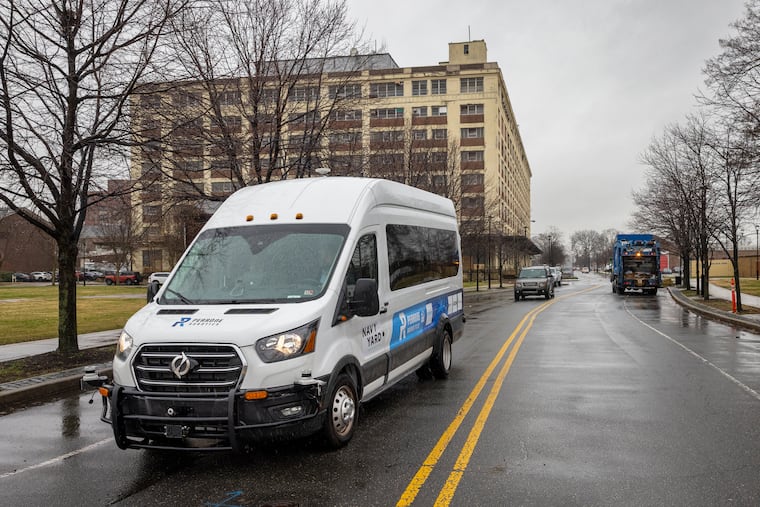Self-driving shuttles are coming to the Navy Yard to link commuters to SEPTA
Pa.’s first self-driving shuttle was unveiled at the Navy Yard. It will take employees to NRG Station on the Broad Street Line.

Nick Pilipowskyj didn’t need to have his hands on the steering wheel as his shuttle van negotiated an empty parking lot in the Navy Yard. The van was making precise turns itself based on the route it “knew,” guided by two GPS units on its roof that kept the vehicle on course.
A robot was at the controls, and all was well as a wintry rain fell.
With congratulatory remarks, officials from the Philadelphia Industrial Development Corp. (PIDC), PennDot, and other agencies unveiled Pennsylvania’s first self-driving shuttle Thursday. It will begin testing early next year, and be fully deployed by spring to ferry passengers between the Navy Yard and the southernmost stop on SEPTA’s Broad Street Line, typically a 17-minute ride.
The vehicle, which started as a Ford van chassis, has a 360-degree view of the road and GPS navigation accurate to within 1 centimeter, with radar and LIDAR — a light-based sensing and detection system — Pilipowskyj said.
“We’re able to see everything around us while looking ahead for hundreds of meters and planning three decisions ahead just like [human] drivers do,” said Pilipowskyj, vice president for business operations at Perrone Robotics, the Charlottesville, Va., firm that built the machine.
“We’re not focused on things that are happening on the sides … We’re looking at what’s in the lane,” he said.
The vehicle is programmed to give a wide berth to slower-moving cars, cyclists, and pedestrians, pacing them until it’s safe to pass.
The PIDC, the master developer for the Navy Yard, is working to increase transit access as it embarks on 109 acres of new development. Officials expect that growth to bring 12,000 jobs, 235,000 square feet of retail, and 4,000 new housing units to the sprawling former military base.
Automated passenger shuttles are envisioned as a tool for better connecting the rest of the city and the complex, which is tucked away in the farthest corner of South Philadelphia near the sports stadiums and has little SEPTA transit service.
“It’ll be a critical link as we build out the transit to serve our new employees and the new residents that will come with this development,” said Kate McNamara, PIDC’s senior vice president for the Navy Yard. “We want the jobs to be accessible to all Philadelphians.”
An estimated 95% of the 15,000 employees already at the Navy Yard drive to work, but planners know that the future growth depends in part on more robust transit options. PIDC is working with SEPTA to get regular service to the development. A long-discussed expansion of the Broad Street Line to extend it a mile southward would be expensive and take years to complete. SEPTA officials have not absolutely ruled out that project, but have also said they are looking at other options, such as bus service.
» READ MORE: SEPTA may add bus service to Navy Yard to ease traffic jams
Currently, the Navy Yard operates shuttle buses, with one route from Center City and another that loops between the complex and NRG Station, the last stop on the Broad Street subway line. When they are tested and ready, the autonomous vehicles will be used on the loop to the subway.
The automated shuttle project was developed and financed in cooperation with the Delaware Valley Regional Planning Commission (DVRPC), the city transportation department, Drexel University, and PennDot. A law signed in early November by Gov. Tom Wolf allows autonomous vehicles to operate on the state’s roads — eventually, with regulator approval, they can do so without human drivers as backups.
Perrone Robotics has deployed autonomous vehicles in golf communities, mines, and at logistics yards. At the latter, the technology is able to maneuver semitrailers with the flow of traffic, and park them at loading docks, Pilipowskyj said.
To start, the autonomous Navy Yard shuttles will have two human drivers as safety backups, and later, one human driver, he said. Drivers need about 200 hours of training to get comfortable with the technology and learn how and when to override the robotics, in the event of an emergency or a GPS malfunction.
“As a driver, I can listen for things coming that the van can’t,” he said. “So, if I hear multiple fire trucks and police cars coming from behind that building, I might choose to say you know, I’m not gonna crowd the intersection. I might stop here and wait to see if they are down my road or not.”
Barry Seymour, executive director of the DRVPC, said that the promise of driverless vehicles has been a long time coming. “Today, that day has finally arrived,” he said.